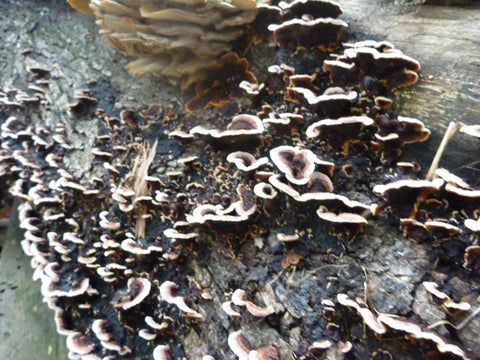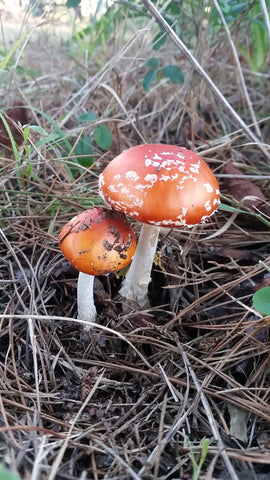< See more articles >
Mould: The Role of Fungi
Written by Tumbleweedau Admin
We are all familiar with fungi in some way or another, from the mushrooms that are a delicious and nutritious part of our diet, to the green moulds that grow on our oranges, lemons and bread. However, if we delve deeper into the world of these fascinating organisms, we find a group that is absolutely vital to sustaining life on earth through their outstanding ability to break down woody, high carbon materials that are highly resistant to decomposition.
Fungi are rather unique organisms in that they are not plants because they can’t make their own food using sunlight, nor are they animals because they don’t have mouths or stomachs. Indeed, biologists have given fungi their very own kingdom in the same way that humans belong to the animal kingdom. The fungal kingdom is one of the largest groups on earth with something like 1,500,000 different species. From a composting point of view fungi are without doubt one of the most important organisms because of their superior ability to break down wood and other substances high in carbon (cellulose and lignin) such as cardboard, dead leaves and straw. One of the more spectacular types in this regard are the so-called bracket fungi that can often be seen growing as wing-like structures protruding from dead tree trunks, often they are highly colourful and are a spectacular addition to the forest floor.

Other fungi that break down woody material in the forest often produce toadstools and mushrooms as their fruiting bodies and these represent the final stage of growth after the thread-like hyphae have digested woody material such as dead roots in the soil below.
As well as the fungi that break down dead woody materials (we will come back to these later when we talk about their role in composting), there are many other types that perform interesting and important roles in our environment, sometimes they are beneficial to us and other organisms, such as mycorrhizal (‘fungus roots’) fungi that live in close association with the roots of many plant species. The fine threads (hyphae) of the mycorrhizal fungi act as an extension of the plant’s root system, acting to dramatically increase the surface area that can absorb soil nutrients that are fed back to the plant in exchange of sugars made during photosynthesis that are used to fuel the growth of the fungus. This is why many Australian native plants are able to grow and even thrive in some of the world’s most infertile soils, such as those in the wildflower wonderland that is south west Western Australia.

Others such as the cinnamon fungus (Phytophthora cinamommi) are rather deadly plant pathogens that cause extensive dieback in Australian forests that is alarming botanists around the country. In this case the fungus invades the plant roots, killing and then decomposing the root tissues to feed itself. Other fungi cause diseases of plant stems and leaves with fungal leaf spots causing circular lesions as the fungal spores germinate and the hyphae radiate out, killing plant cells as they go.
Yet other fungi cause diseases in animals including humans. Yeast infections such as Candida will be familiar to many people as they are a type of fungus that infects various parts of the human body and can cause serious health problems. The torrential rains on the Australian east coast over the summer of 2021-22 created ideal conditions for fungal growth inside as well as outside houses where areas were constantly waterlogged, along with months of highly humid conditions. Many households experienced moulds growing inside their houses, creating a potential health hazard as the fungi often produced the microscopic reproductive spores by the millions which become airborne as their means of spread. Wherever you may encounter fungi around the home, whether it be indoors or out you must be careful not to breath in the spores if the fungal colony is disturbed. It should be said that a well-made compost heap is an absolutely perfect environment for fungal growth which we want to encourage as part of the natural cycle of decomposition. But it is vital, especially if you are prone to respiratory problems such as asthma, that you wear a protective mask and wash your work clothes if you have been playing with your compost heap. The same applies also to worm farms. The covid pandemic has had the benefit of introducing us to the health benefits of a suitable mask, and these will be perfect for when you are turning the compost heap, or indeed collecting rotting leaves or grass clippings from around the garden.
Let’s talk a bit more about the role of fungi in breaking down all of the woody materials in your compost heap. There is a good reason why wood has been used for many thousands of years as a building material. That is because it is incredibly durable in the natural environment due to the presence of some very tough molecules called lignin and cellulose that form the backbone of woody materials. You have heard of the importance of fibre as part of your daily diet, because even though we are unable to digest fibrous components of our food, these molecules play a very important role in gut and bowel health in feeding the all-important microflora in our gut that keeps our digestive system healthy. So, if woody materials are so resistant to being broken down, why is the world not completely smothered in this stuff? It turns out that fungi are the key organisms that have evolved to recycle woody materials in the environment.
The reason that fungi are the best microbes at breaking down the tough high carbon/low nutrient materials in your compost is that they spread and grow vigorously through their thread-like growth structures (hyphae) that can decompose the tough brown stuff that is too dry, acidic, or too low in nutrients for the other common microbes such as bacteria that are found in the compost heap. Most fungi live in the outer layer of compost and certain types known as thermophiles can thrive at the relatively high temperatures of a ‘hot’ compost heap, often as high as 75 degrees C. There are others that thrive at lower temperatures as the heap cools down, but they typically need oxygen to survive which is why turning your heap with a tool such as the Tumbleweed ‘Compost mate’ (aka the compost corkscrew).
As the fungal threads (hyphae) multiply and grow through the compost heap they seek out anything they can digest, but they are particularly competitive as mentioned earlier when it comes to decomposing woody stuff. The hyphae releases enzymes that are very effective at breaking down the cellulose and lignin molecules by chopping the up into their constituent substances, mainly carbon, hydrogen and oxygen. What is left over at the end is that wonderful black stuff called humus that is the end product of composting. Other microbes such as bacteria are single cell organisms that form small colonies and therefore have much less ability to spread through a compost heap as easily as fungi.
How can we best encourage the right types of fungi in our composting systems? When you are making compost heaps there are usually plenty of fungal spores present in the materials you are adding to the heap as there are airborne spores floating around in the air and fungal hyphae will be present in fallen leaves and lawn clippings. It never hurts to also add thin layers of finished compost to your heap, or if that is not available, then keep a pile of rotting leaves or lawn clippings around as they will do the same job. Animal manure, either fresh or dried, will also introduce the right types of fungi as well as feed them, because manure is usually full of undigested fibre of the type that these fungi thrive on. While dry conditions are not a game breaker for the fungi we want to encourage, it is best to keep your compost moist (but definitely not wet) as this allows for plenty of aeration as well as building the humidity that helps the fungi grow as fast as possible to get our compost ready for the garden. Turning the heap once a week or so is also a great way to keep it aerated and allow the fungi to more easily reach the woody material buried inside the heap (remember to wear a mask when turning or handling your compost).
Fabulous fungi – where would we be without them? Piled high and deep in woody stuff the world over.







